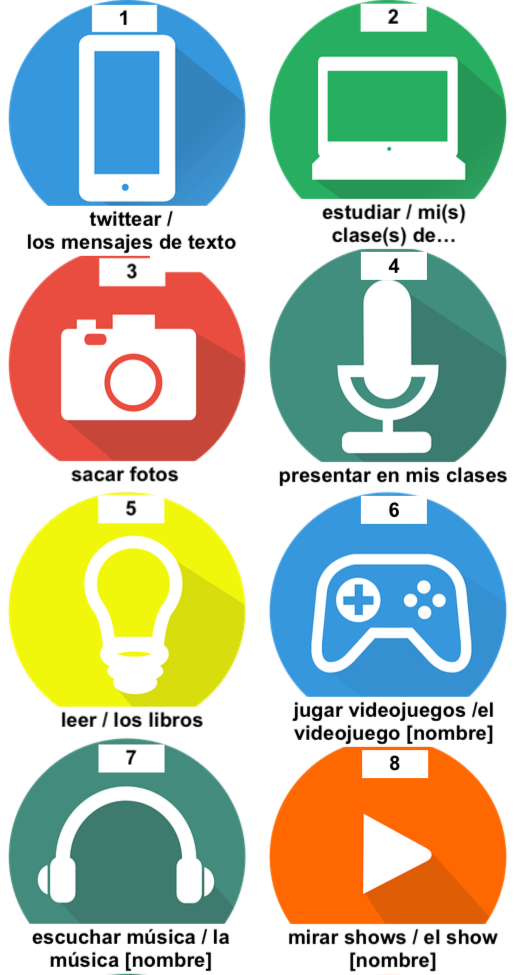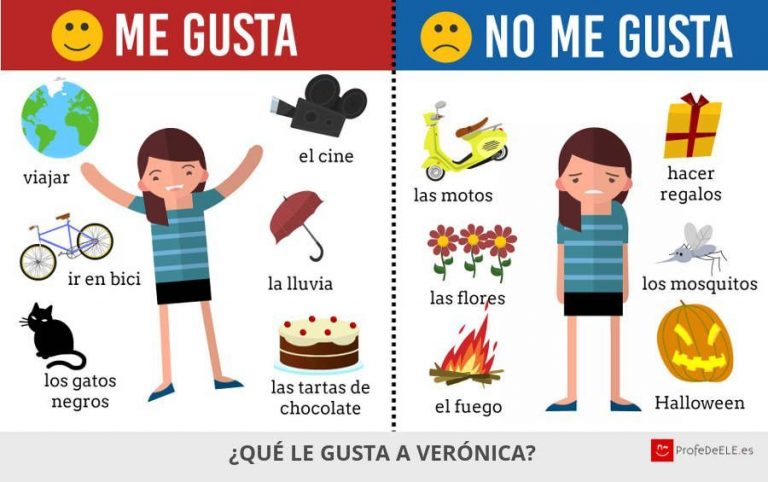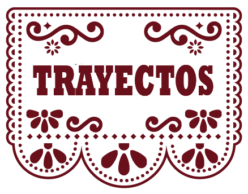El verbo gustar + infinitive & gustar + noun: Uso y forma
Sábado de limpieza
Kate es de una familia bicultural. Su papá es de los Estados Unidos y su mamá es española. Kate usa el español con su mamá. Es sábado y Kate hace las tareas de la casa. Escribe un texto a su mamá en Tejas. ¿Cómo está Kate? ¿Por qué?

En el mensaje de texto, Kate y su mamá usan el verbo gustar. Look at the forms of this verb. What do you notice about these forms? Pay attention to the words/phrases that come after the verb.
No me gustan las tareas de la casa.
No me gusta… limpiar el baño. Me gusta planchar.
Now let’s look at the example we saw in the dialogue between Kate and the real estate agent:
A mí me gusta el apartamento.
What can you hypothesize about this verb? What is important when we conjugate it? Again, the clue is in the words/phrases that come after it.
Gustar is a special verb that cannot be conjugated like other -ar verbs. As you can see in the examples above, when Kate says she likes the apartment, she says “me gusta”, not “yo gusto”. The conjugation of gustar does not depend on the person who likes or dislikes, but on what is liked. For example, if you talk about something that you like to do, you will need the singular form of gustar (gusta) + the verb in the infinitive that is used to refer to that activity (e.g., Me gusta planchar). The same is true if you refer to only one thing that you like: Me gusta el apartamento. If you want to talk about many things you like or dislike, you will need to use the plural form of gustar, gustan (e.g., No me gustan las tareas del hogar).
Also, in the examples, you must have noticed the pronoun me before gustar. Well, this is an example of indirect object pronoun, which refers to object or the person who receives the action of a verb indirectly (in English, to whom or for whom). In Spanish, we use indirect object pronouns with gustar. Have a look at this table. What do you notice about the use of gustar and the indirect object pronouns we need? What is the optional part?
El verbo gustar
| Number | Optional | (NO) | Indirect object pronouns | Gustar |
| Singular | (A mí) | me | gusta el apartamento. | |
| (A ti) | te (informal) | gustan las tareas del hogar. | ||
| (A usted/Ud.) | le (formal) | gusta limpiar el piso. | ||
| (A él/ella) | le | gustan los libros. | ||
| Plural | (A nosotros/nosotras) | nos | gusta la clase de español. | |
| (A vosotros/vosotras) | os | gustan los exámenes. (España) | ||
| (A ustedes/Uds.) | les | gusta cocinar. | ||
| (A ellos/ellas) | les | gusta lavar los vidrios. |
Ahora mira este video. It offers a summary of the way in which we use gustar, and it introduces other likes-dislikes verbs that behave in a similar way as gustar.
![]() Me gusta y no me gusta
Me gusta y no me gusta
Attribution: By Daniel Hernández Ruiz, licensed under CC BY 4.0.
Ahora hablamos de nuestras preferencias y gustos. Es hora de Actividad 3-9. Más sobre gustos Visita la página en http://bit.ly/ActividadGustar y completa las actividades 1, 2 y 3. Be ready to discuss your results with other classmates. ¿Tienes unas palabras nuevas? Add the new words you have learned to your glossary for this module. Paso 1. Trabaja con un@ compañer@. Usa el gráfico a continuación y compara tus gustos y los gustos de tu compañer@. You can also talk about other likes and dislikes. Remember to ask your instructor for help! Discuss 5 or 6 likes and dislikes. E1: ¿Qué te gusta hacer? E2: Me gusta twittear. ¿Y a ti/a vos? E1: No me gusta twittear. Me gusta Instagram. Paso 2. ¿Con quién? Now write the persons with whom you like/dislike to do the activities in Paso 1. Use con (with) to help you formulate your responses. E1: No me gusta twittear con mis padres. Paso 3. ¿Por qué? Now write a reason why you like or dislike the activities in Paso 1. Use porque to expand your sentences. E1: No me gusta twittear con mis padres porque son aburridos. A student talks about her likes and dislikes. Listen to what she says, using the image below for help. Paso 1. Escucha a Verónica. ¿Tienen Uds. los mismos gustos? Escribe las similitudes. Escucha a Verónica otra vez y decide si estas afirmaciones son Ciertas (C) o Falsas (F). Trabaja con un@ compañer@. Work with someone you haven’t worked with before. Now compare your likes and dislikes with Verónica’s. ¿Son ustedes similares a Verónica? To discuss your preferences, use gustar, of course! Also, try to ask more questions to get to know your classmate. E1: A Verónica le gusta mirar películas y a mí me gusta mirar películas también. Me gustan los shows de detectives. E2: A mí también me gustan los shows de detectives. ¿Cuál es tu show favorito? E1: Shetland. ¿Cuál te gusta? E2: Me gusta Bodyguard. Trabaja con un@ compañero@ y practica tu español en esta situación social. You need to use the vocabulary and structures you have learned so far. Change roles and partners after practicing each situation once. Estudiante 1. Call your best friend from high school and tell them about your new roommate and apartment off campus. Describe your roommate and apartment, including: Estudiante 2. Your best friend from high school calls you to tell you about their new roommate and apartment in college. Ask questions about:![]() ¡Manos a la obra!
¡Manos a la obra!
![]() Actividad 3-10. ¿Qué te gusta hacer?
Actividad 3-10. ¿Qué te gusta hacer?

E2: Me gusta usar Instagram con mis amigos.
E2: Me gusta usar Tik Tok con mis amigos porque es divertido.
![]() Actividad 3-11. ¿Qué le gusta a Verónica?
Actividad 3-11. ¿Qué le gusta a Verónica?
![]() Paso 2
Paso 2
1. Para Verónica, el mundo no es interesante.
C
F
2. Verónica vive en una ciudad.
C
F
3. A Verónica le gusta caminar a la universidad.
C
F
4. A Verónica le gustan los perros de color negro (black).
C
F
5. La celebración favorita de Verónica es Halloween.
C
F
6. A Verónica no le gustan los mosquitos.
C
F
7. A Verónica le gusta comprar regalos (gifts) para sus amigas.
C
F
8. A Verónica le gusta Netflix.
C
F
![]() Paso 3.
Paso 3.
![]() ¡Conversemos!
¡Conversemos!
Click on the following button to continue using your new structures.
Now it’s time to continue learning about the Hispanic/Latinx contribution in this country:


